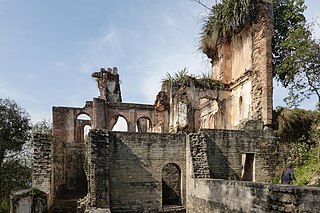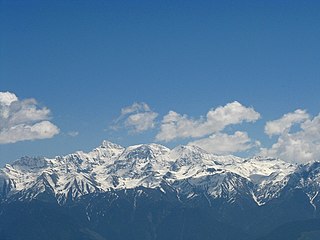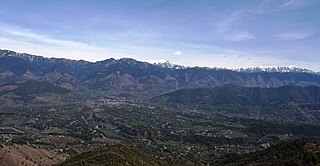
Shimla is the capital and the largest city of the northern Indian state of Himachal Pradesh. In 1864, Shimla was declared the summer capital of British India. After independence, the city became the capital of East Punjab and was later made the capital city of Himachal Pradesh. It is the principal commercial, cultural and educational centre of the state.

Hamirpur district is in the Indian state of Himachal Pradesh. The headquarters of the district are in the town of Hamirpur. With an area of 1,118 square kilometres or 432 square miles, it is the smallest district of Himachal Pradesh.

Una district is a district in the Indian state of Himachal Pradesh. Una shares its border with the Hoshiarpur and Rupnagar districts of Punjab and Kangra, Hamirpur, and Bilaspur districts of Himachal Pradesh. The terrain is generally plain with semi hills.

Vaisakhi, also known as Baisakhi, marks the first day of the month of Vaisakh and is traditionally celebrated annually on 13 April and sometimes 14 April. It is seen as a spring harvest celebration primarily in Punjab and Northern India. Whilst it is culturally significant as a festival of harvest, in many parts of India, Vaisakhi is also the date for the Indian Solar New Year.
Bilaspur is a town and a municipal council in Bilaspur district in the Indian state of Himachal Pradesh.

Gorakhnath Math, also known as Gorakhnath Temple or Shri Gorakhnath Mandir, is a Hindu temple of the Nath monastic order group of the Nath tradition. The name Gorakhnath derives from the medieval saint, Gorakshanath, a yogi who travelled widely across India and authored a number of texts that form a part of the canon of Nath Sampradaya. The Nath tradition was founded by guru Matsyendranath. This math is situated in Gorakhpur, Uttar Pradesh, India within large premises. The temple performs various cultural and social activities and serves as the cultural hub of the city.

The Pir Panjal Range is a range of mountains in the Lower Himalayan region located in the Western Himalayas of northern Indian subcontinent. It runs southeast to northwest between the Beas and Neelam/Kishanganga rivers, in the Indian state of Himachal Pradesh and Indian-administered union territory of Jammu and Kashmir, with its northwestern end extending into territory administered by Pakistan. The Himalayas show a gradual elevation towards the Dhauladhar and Pir Panjal ranges. Pir Panjal is the largest and westernmost range of the Lesser Himalayas. Near the bank of the Sutlej River, it dissociates itself from the main Himalayan range and forms a divide between the Beas and Ravi rivers on one side and the Chenab on the other. Further west, the Pir Panjal range forms the southwestern boundary of the Kashmir Valley, separating it from the hills of Jammu region, forming a divide between the Jhelum and Chenab rivers.
Punjabi Hindus are adherents of Hinduism who identify ethnically, linguistically, culturally, and genealogically as Punjabis and are natives of the Punjab region of the Indian subcontinent. Punjabi Hindus are the third-largest religious group of the Punjabi community, after the Punjabi Muslims and the Punjabi Sikhs. While Punjabi Hindus mostly inhabit the Indian state of Punjab, as well as Haryana, Himachal Pradesh, Delhi, and Chandigarh today, many have ancestry across the greater Punjab region, which was partitioned between India and Pakistan in 1947.

A kuladevata or kuladevi, also known as a kuladaivaṃ, is an ancestral tutelary deity in Hinduism and Jainism.
The place of Sidh Baba Balak Nath's gufa Deotsidh is a pilgrimage town in Barsar tehsil, Hamirpur district, Himachal Pradesh, India. The nearest broad gauge railway station is in Una district, about 60 kilometres (37 mi) distant, and the nearest airport is about 172 kilometres (107 mi) away in Chandigarh.

In Hinduism, the yatra (pilgrimage) to the tirthas has special significance for earning the punya needed to attain the moksha (salvation) by performing the darśana, the parikrama (circumambulation), the yajna, the Dhyana, the puja (worship), the prarthana, the dakshina, the seva, the bhandara, etc. These sacred places are usually located on the banks of sacred waters, such as sacred rivers or their tributaries, the kundas, the ghats, or the stepwells, or the temple tanks.

The Śāradā, Sarada or Sharada script is an abugida writing system of the Brahmic family of scripts. The script was widespread between the 8th and 12th centuries in the northwestern parts of Indian Subcontinent, for writing Sanskrit and Kashmiri. Although originally a signature Brahminical script created in the valley, it was more widespread throughout northwestern Indian subcontinent, and later became restricted to Kashmir, and is now rarely used, except by the Kashmiri Pandit community for religious purposes.

Joginder Nagar Valley is a valley in the Indian state of Himachal Pradesh. The valley contains the town of Joginder Nagar, Bir-Billing, Chauntra and various other hill resorts surrounded by mountains on all sides. The valley falls in the mid-hill zone of the Dhauladhar mountain range in the foothills of the Indian Himalayas. Geographically, the valley starts near Ghatta at its westernmost point and stretches south-eastwards up to Ghatasani, 15 kilometres from the main town. On an average, the valley is stretched 20 kilometres in length and 10 kilometers in width.

Mandi is a major town and a municipal corporation in Mandi District in the Indian state of Himachal Pradesh. It is situated 145 kilometres (90 mi) north of state capital, Shimla in the north-west Himalayas at an average altitude of 880 m (2,890 ft) Mandi is connected to the Pathankot through National Highway 20 and to Manali and Chandigarh through National Highway 21. Mandi is approximately 184.6 km (114.7 mi) from Chandigarh, the nearest major city, and 440.9 km (274.0 mi) from New Delhi, the national capital. In the 2011 Indian census, Mandi had a population of 26,422. Mandi district is currently the 4th largest economy in the state. Mandi has the second highest sex ratio of 1013 females per thousand males, in the state.
Chakmoh is a village in Hamirpur district of Himachal Pradesh, India. It is surrounded by the thick forests having various types of trees mostly Cheed. Baba Balak Nath Temple Deotsidh is also situated here. A lot of devotees come here every year to worship Baba Balak Nath. The village is well connected with roads and have the facilities of electricity and water. The village has a long history and a population of approximately 2000 people. There are two colleges, both of which are affiliated to Himachal Pradesh University Shimla.:
Yogi Nath is a Shaivism-related group of monks which emerged around the 13th-century. They are sometimes called Jogi or simply Yogi, and are known for a variety of siddha yoga practices.

The Masrur Temples, also referred to as Masroor Temples or Rock-cut Temples at Masrur, is an early 8th-century complex of rock-cut Hindu temples in the Kangra Valley of Beas River in Himachal Pradesh, India. The temples face northeast, towards the Dhauladhar range of the Himalayas. They are a version of North Indian Nagara architecture style, dedicated to Shiva, Vishnu, Devi and Saura traditions of Hinduism, with its surviving iconography likely inspired by a henotheistic framework.
Barsar is a historical town which has its roots linked to the Sidh Shri Baba Balak Nath Ji, a Hindu deity located in the Hamirpur district of Himachal Pradesh. Located primarily on the Foothills Of Western Shivalik Range Of The Outer Himalayas on National Highway 503 A, it is a major Business and Educational Hub in the district. Barsar Hilltop overlooks Lake Govind Sagar due South West and The Dhauladhar Himalayas due north. Founded by Rajput Prince as a Princely state, used their clan name Barsar as the name of state. After separation of India it was merged in India. Now it is also a part of Himachal Pradesh. Barsar is one of the most developing and enhancing educational locations in the state and it also serves as one of five tehsil headquarters in the Hamirpur district. Barsar Hilltop separates Hamirpur to Una District at an elevation of 1015 M above sea level.
Mangal is a former princely state in north India ruled by Chandravanshi Sen Rajputs.Mangal state like Mandi State was an off shoot of Suket State. Rana Surender Singh is its present head.
Jubbal State was a non-salute state of the Simla Hill States Superintendency of the Punjab States Agency. Thought to have been founded in the twelfth century, it merged with the Indian Union in 1948.












